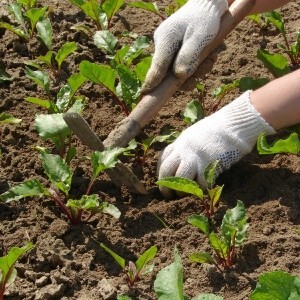
It's a universal experience among gardeners, especially in the spring-yanking out a weed only to find out later it was really a "wanted". Weeds will do whatever it takes to survive, even disguising themselves as other plants. Here are some helpful tips for telling your your seedlings apart from your weedlings.
Weeds are pioneers and they usually grow faster than wanted seedlings. Most are up and growing in the spring long before your wanted seeds are planted in the garden. Prepare garden beds several weeks before planting. Dormant weed seeds will germinate in the disturbed soil and produce flushes of weed seedlings that can be removed before planting your garden seeds. Take note of what the weedlings look like as you remove them from the soil. You may also find it helpful to take a camera with you and keep digital files of weedlings on your computer for easier identification later on.
Make it easy to identify weeds by sowing your seeds in straight lines or rows rather than broadcast sowing them. Once germinated, your seedlings (which will all look similar) will easily outnumber the weedlings. Anything growing outside of the line can be considered fair game when it's time to weed.
This works well if you're growing a plant for the first time and you've never laid eyes on the seedlings. Set aside 1/2 dozen of the seeds your sowing outdoors, and plant them in a pot near a sunny windowsill. Your crop of weed-free seedlings will make it easy to tell the weeds from the "wanteds" once they pop up in the garden. At most, you'll be out a few seeds. At best, you may end up with 1/2 dozen additional transplants for your garden.
Plants are either monocotyledons (monocots) or dicotyledons (dicots). Seedlings from monocots have one seed leaf, and include the grasses, palms, aroids and bulbs. Seedlings from dicots have two seed leaves, and include most other types of garden plants. If you have a seedling with only one leaf (monocot) where you know you've only sown dicots, then the seedling is probably a weed. If you've sown seeds of only monocots and your seedling has two leaves (dicot), it is probably a weed.
Sometimes it's best to avoid uncertainty and settle on a wait-and-see approach. As plants grow into their true leaves, it usually becomes easy to tell the weeds and seedlings apart. And with time, comes experience. Once you have been planting and weeding the same garden beds over several seasons, you will find it much easier to recognize the weeds from the "wanteds".

About The Author: Ellen Brown is an environmental writer and photographer and the owner of Sustainable Media, an environmental media company that specializes in helping businesses and organizations promote eco-friendly products and services. Contact her on the web at http://www.sustainable-media.com
Add your voice! Click below to comment. ThriftyFun is powered by your wisdom!
I can sure relate to that topic! Several years ago I pulled out a large patch of Hellebore seedlings before I realized that they didn't look like weeds. They didn't look like Hellebores either, but fortunately I left the rest alone and now I warn others.
Add your voice! Click below to comment. ThriftyFun is powered by your wisdom!